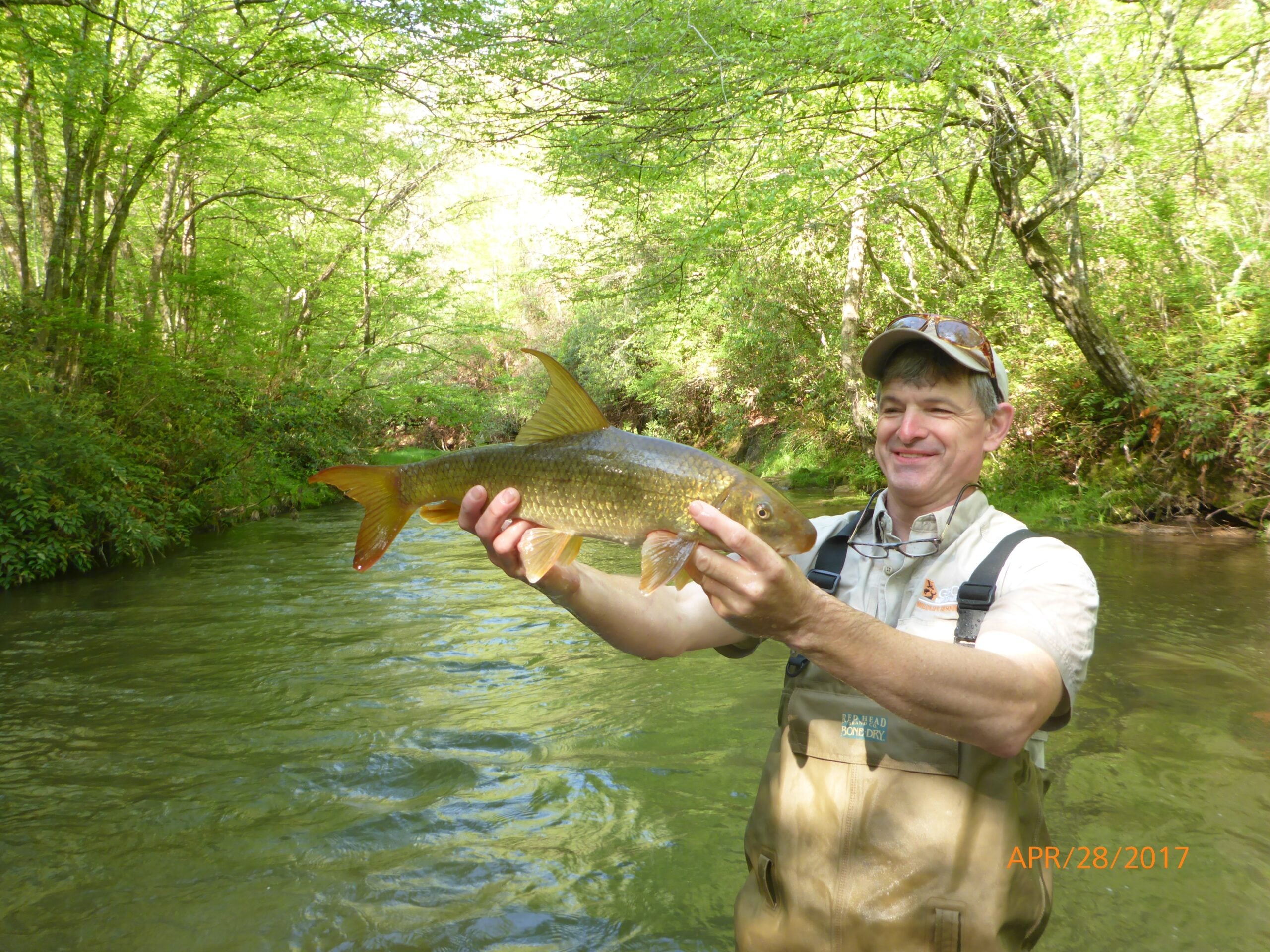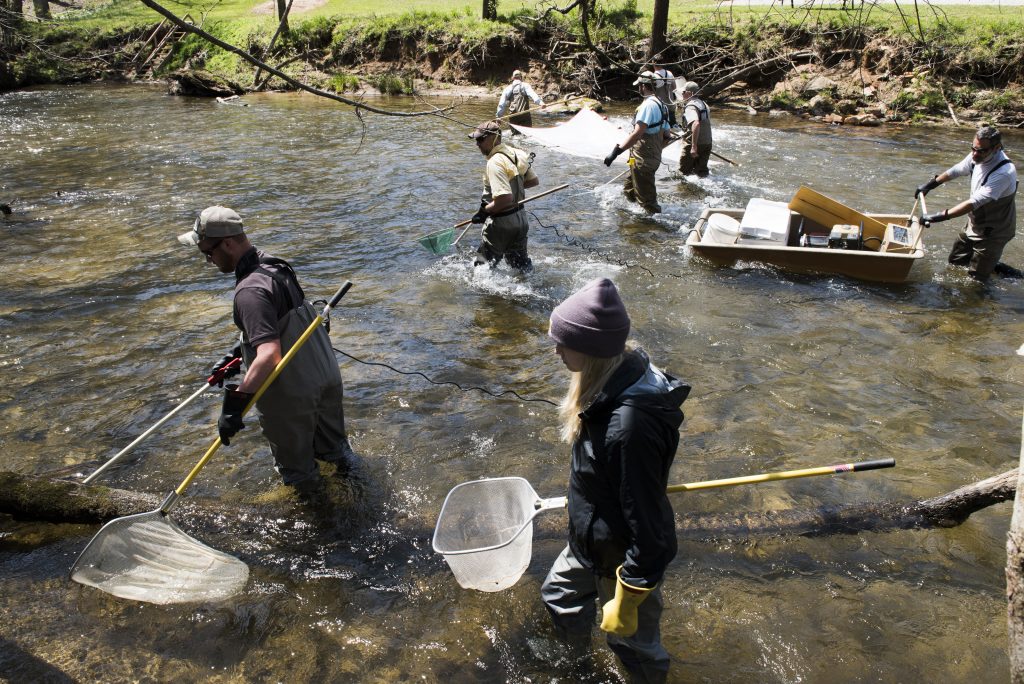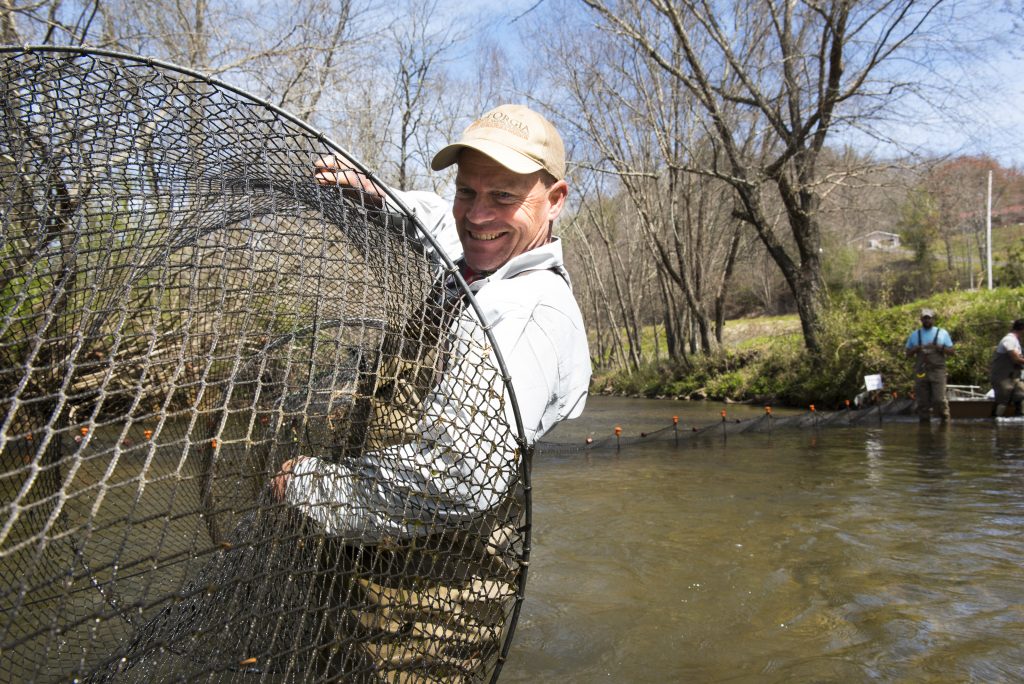Searching For The ‘Salmon Of The South’

Brett Albanese, biologist with the Georgia Department of Natural Resources, holds a sicklefin redhorse.
Peter Dimmick / Georgia Department of Natural Resources
Georgia is a hotspot for fish.
There are more species of fish in Georgia’s rivers and streams than almost any other state in the nation.
There’s one that scientists didn’t even realize existed until the 1990s. It’s called the sicklefin redhorse, and now that scientists know that it’s out there, they’re trying to protect it.
The sicklefin redhorse is a big, shimmering fish that can grow to be two-feet long, with a sickle-shaped fin on its back tipped with red. Like salmon, the sicklefin migrates upstream to spawn. Unlike most salmon, it doesn’t die after the trip.
“It’s a pretty great fish,” said Brett Albanese, a biologist with the Georgia Department of Natural Resources.
Great, but obscure. And researchers suspect the fish is rarer than it once was.
Scientists have known about this species for just a few decades. It lives in a couple river systems, mostly in North Carolina, but it’s also in Georgia’s Brasstown Creek.
Albanese said in Georgia’s defense, the fish live in the state for a few months of the year, and their range is limited. More limited now, because dams block the sicklefin redhorse’s spawning migration.
While the fish is relatively new to western scientists, the Cherokee Indians have known sicklefin redhorse for centuries. Their name for the fish, with its pointed red fin, is junighitla, which translates to “wearing a red feather.”
“It is a culturally significant fish, where it historically provided Cherokee with an abundant food resource,” said Mike LaVoie, natural resources program manager for the Eastern Band of Cherokee Indians.
Related: Georgia Initiative Brings Business To The Table To Save A Rare Animal
The tribe is working with Georgia, North Carolina, the U.S. Fish and Wildlife Service, power companies and environmental groups to study the sicklefin redhorse, reintroduce it to more places and keep it off the endangered species list.

On a cold spring day in the Blue Ridge Mountains, about a dozen researchers pulled on waders and scrambled down into the Nottely River, near Blairsville.
They were there to shock fish.
It’s one way to get a sense of the fish in a river: give them enough of a jolt so that their muscles contract, and they float. Then researchers can identify them, catch them, and hold onto them if they need.
“We’re going to walk upstream a little ways, and there’s a couple woody habitats we want to stop and shock,” said Ryan Heise, a biologist with Duke Energy.
The barge shocker was a few feet long, with a generator mounted on top. Some of the researchers used wands to send currents of electricity into the water. Others were armed with nets, ready to catch whatever got zapped.
The group waded over rocky shallows and through waist deep pools. They turned up river redhorse, black redhorse and golden redhorse. But no sicklefins.
Which was actually kind of the point.
Scientists believe the sicklefin redhorse probably once lived in the Nottely River, but it doesn’t seem to be there anymore. Groups working to protect the fish hope to reintroduce it in some places, including potentially in this river, upstream of Lake Nottely, but before they can do that, they need to make sure the fish isn’t already there.

The Eastern Band of Cherokee Indians is interested in the sicklefin redhorse not just for cultural reasons, but also for bureaucratic ones, said LaVoie. If the fish was protected by the Endangered Species Act, there would be more hoops to jump through if, for instance, they wanted to change their forest management practices.
That’s what brings the power companies Duke Energy and TVA to the table, too. With an endangered fish in a river, hydropower dam licensing has more red tape.
LaVoie said they’re also working on the sicklefin redhorse’s reputation.
“They’re often seen as kind of trash fish, being tolerant of degraded habitat and really providing little social or ecological value,” said LaVoie.
Sicklefin and the other redhorses are suckers, a group of fish maligned as bottom feeders, but that’s wrong, said Albanese.
“This group of fish is not a sport fish, and hard to identify. So they’re often under-studied,” he said, with a more positive view of suckers to offer:
“Sometimes people will say, ‘Suckers are the salmon of the South,’” he said. “They need clean gravel for spawning, and they have a migratory life history.”
After the Nottely River, Albanese went to a pristine stretch of Brasstown Creek, near Young Harris. Phlox and lilies speckle the path to the creek, ferns and moss line the banks.
Standing in the creek, Albanese pointed out a sicklefin redhorse as it darted by. He said protecting the fish is good for north Georgia rivers and streams, too, since, contrary to sucker stereotypes, it really does need a clean environment.
“If we can keep the sicklefin population strong we’re going to have nice rivers,” he said.






